H / V signal system
The H / V signal system ( main / distant signal system ) is a railway signal system that has been used in Germany since the second third of the 19th century and can still be found today, especially in the network of the former German Federal Railroad . The signals were initially designed as form signals , but with the Signal Book of 1935, corresponding light signals were also introduced (which corresponded to the night signals of the form signals) and which in the meantime have largely replaced the form signals in this area. Up to 1930, not only speeds but also routes were often signaled: For this purpose, there were also main shape signals with three signal wings, which, as “signals that will no longer apply in the future”, had persisted even 50 years later.
Based on the H / V system, further signal systems were developed, from 1959 the former Deutsche Reichsbahn in the GDR took a special route in the relevant current network , in which signals of the H / V system now only exist as form signals, some of them in simplified variants.
In the longer term, the existing main and distant signals of the H / V system are to be replaced by the combination signal system (Ks).
H / V system
Main signals
A main signal transmits stopping or slowing down instructions to the driver for the following route section. In a rough comparison, it corresponds to a traffic light in road traffic with the significant difference that a signal showing “driving” only applies to one train, while a “green” traffic light allows any number of vehicles to pass by.
Main signals had been provided with the abbreviation Hp since the 1935 Railway Signal Regulations , with the 1959 signal book the Deutsche Reichsbahn introduced the abbreviation Hf , which with the standardization in 1994 was now Hp . The Deutsche Bahn took over the so-called absolute stop from the Deutsche Reichsbahn for the Hp 0 signal, which was only valid for trains from 1935 to 1959 and from then until 1994 for the Deutsche Bundesbahn, but not for shunting departments .
Pre-signals
Even at medium speeds, the stopping distances of trains are longer than the visibility, especially in bad weather or in curves. A moving train could not come to a stop in time before the signal when it recognizes a stop. Even if the signal is set up sufficiently far in front of the danger point, the problem still remains that the driver does not know when to continue.
A braking distance of 900 m results in a maximum speed of a little more than 160 km / h. Therefore, on routes that are approved for 160 km / h, there is a distant signal 1000 m in front of every main signal, which shows the driver which signal aspect to expect at the main signal. At this distance (nominal braking distance plus braking distance reserve of 100 m) a train can easily come to a standstill before the main signal.
Since the driver may have to initiate the braking process from the distant signal, it must not be overlooked. Therefore, a distant signal on the open route is usually announced by distant beacons. If a distant signal is close behind a road junction, at least one distant signal beacon should be placed behind the road junction. There should be no distant beacons in front of the route junction if there is no distant signal for other routes.
Advance signals had been provided with the abbreviation Vr since the 1935 Railway Signal Regulations , with the 1959 signal book the Deutsche Reichsbahn introduced the abbreviation Vf , with the 1994 standardization it is now Vr again .
Up until 1935 there was only one common term for the announcement of the main signal terms Hp 1 and Hp 2. With increasing speed it was no longer sufficient in every case to only be able to recognize when the main signal became visible whether it was driving at maximum speed or at 40 km / h stands. As a consequence, three-aspect distant signals were introduced, which can indicate both terms with different distant signal terms. The introduction of the three-aspect distant signals should happen in parts. Advance signals that could only show one of the two driving terms were given fixed additional wings or disks in this context to ensure clear signaling. Trains that passed a three-aspect main signal, which was only announced by a two-aspect distant signal, as planned on Hp 1, then had to be set at the main signal if they were to run unscheduled on Hp 2.
At speeds above 160 km / h, the procedure becomes unsafe because the probability increases that the distant signal will be overlooked. In addition, the necessary distance between the pre-signal and the main signal would be disproportionately large. This is why trains use a driver's cab signaling system for higher speeds , in Germany LZB or ETCS .
history
General history
Already in the early history of the railway - even after several serious railway accidents - the realization prevailed that driving at intervals , combined with the fact that the train driver was only given framework driving times , was not suitable for adequate operational safety. Driving at a distance gained supporters who initially faced considerable technical difficulties: If there was only one train on the route between two stations, this had to be communicated: Initially, the optical telegraph was primarily used for signaling between two stations (train stations ) Application.
With the invention of electrical telegraphy by Carl August von Steinheil , Samuel FB Morse and others, this problem could be eliminated, in Germany for the first time from 1849 on the Royal Hanover State Railways , but this did not eliminate the problem that the telegraph did not provide any information to the train crew transmitted.
Here a variant of the optical telegraph was used, namely balloon or basket signals, in which a basket or balloon raised on a pole signaled to the train crew “stop” or “drive”. First used in 1832 on the Newcastle & Frenchtown Railroad in the USA, this system also spread to Germany, Austria and other countries. However, these signals were still used to transmit information between the stations. The oldest German long-distance railway, the Leipzig-Dresdner Eisenbahn-Compagnie (LDE), had already developed and introduced a message transmission system that was differentiated into 24 individual signals in 1837 and laid it down in Germany's first signal book. On September 1, 1840, she introduced balloon mast signals.
In 1841 the world's first wing signal was installed in the New Cross Gate station of the London & Croydon Railway , which was used exclusively to instruct train crews. When setting up the second wing signal, a mutual signal dependency was built in for the first time worldwide by Charles Hutton Gregory.
This initially had no consequences in Germany. While the balloon mast signals were gradually replaced by wing signals (at the LDE as early as 1842), the signaling for the transmission of information between the railway attendants followed in 1846 , first at the Thuringian Railway Company and in the same year at the LDE. From then on, the balloon signals and wing signals were increasingly used only for the transmission of messages to the train crew, in particular travel and stop commands, from which the form signal system with main and later pre-signals emerged.
The increasing spread of the Morse telegraph from 1849 onwards prompted the Technical Commission of the Association of German Railway Administrations (VDEV) to standardize it from 1850, which ultimately resulted in a signaling system in 1865 , which was adopted by the Association's meeting in Mainz in 1867.
Railway signal regulations 1872/1875
In 1872 the Railway Signaling Regulations (ESO) were issued for the states of the North German Confederation . It followed the resolutions of the VDEV, but was modified in 1873 in the area of the Prussian State Railways : They introduced the distant signal instead of the distance signal. This Prussian signal order was then expanded in 1875 by a separate chapter that described the signaling in Bavaria. In addition, pre-signals for entry signals (at that time called station termination telegraph) were generally introduced. Such distant signals were set up by order of the authorities, whereby a dependency between the entrance signal and the associated distant signal was mandatory. Wing mast signals were now generally only valid for trains; with the exception of Bavaria, they were of no significance for shunting.
The unification process for the German railways took a long time, the ESO only described the signs on the wing mast signals for stop (wing horizontal, night signal a red light) and drive (wing upwards, night signal a white light) at the main signals and performed for the pre-signals a green disc (night signal a green light), which was turned away or folded away when the associated main signal was moving (night signal a white light). In 1879 there were still 24 different versions <- for what ?? ->. One of the important deviations was Bavaria, where signal wings could hang down on exit signals (signal conception, quiet, a blue light at night), which indicated that no train journeys were to be expected on the tracks in question.
In 1880, the Royal Saxon State Railway proposed equipping the entry signal with several wings, with a single wing pointing upwards to the right being intended for travel over points without a branch, while several wings pointing upwards to the right were intended for journeys into branching tracks (night signal one or more green lights depending on the number of wings). The ESO allowed up to three wings to signal different routes.
In 1885 the Royal Bavarian State Railways introduced exit signals.
Railway signal regulations 1892
While the railway signaling order of 1872 with its additions was more of a recommendation, after a fundamental revision in 1892 it became the basis for the entire German Empire, but the Bavarians retained their exceptions. The main innovation was that the concept of travel on the main signals in the night signal was changed from white to green light.
Bavaria's proposal, which did not have route signaling on main signals, but only speed signaling by means of one or two wings, to generally introduce this in this way, was rejected in 1897 because the distant signal attached to the same mast, which was folded diagonally and the two halves one behind, was technically rejected The arrow pointing to the top right resulted, again was not carried by the other tracks.
In 1898 the first self-blocking system was introduced on the Wuppertal suspension railway with only light signals. In 1902, advance signals were finally prescribed before block and cover signals.
Railway signal order 1907
The railway signaling order of 1907 was for the first time legal in the entire German Empire. Saxony had prevailed, which on the one hand eliminated an unbearable contradiction ( green meant driving at a main signal, but caution at a distant signal ) by introducing the yellow light at distant signals for caution , while the green light now meant expecting free travel . Advance signals should now show double lights rising to the right as night signals in order to clearly distinguish them from main signals.
The yellow painting of the distant signal disc was also introduced with the ESO 1907.
Bavaria retained its special features with regard to the use of white and green lanterns for night signals.
After the First World War, the signals were further standardized. The biggest change after the merging of the Länderbahn into the Deutsche Reichsbahn was that in 1921 the Bavarian special routes with regard to the distant signal disc and the use of white and green light were formally abolished.
In 1930, due to a change in the ESO, route signaling was finally abolished and replaced by speed signaling.
Signal aspects
Note: The signal patterns of the distant signals Vr 0, Vr 1 and Vr 2 correspond to the area of the former German Federal Railroad. In the area of the former Deutsche Reichsbahn, the additional wing is white with a red border.
Hp 0 / Vr 0 |
|||
| Signal aspect | Shape signal | Light signal | |
|---|---|---|---|
| Day sign | Night sign | ||
|

|

|
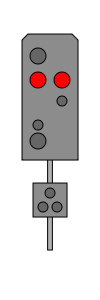
|
|
|
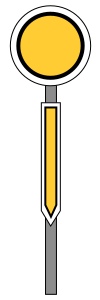
|

|

|
Hp 1 / Vr 1 |
|||
| Signal aspect | Shape signal | Light signal | |
| Day sign | Night sign | ||
|
|

|
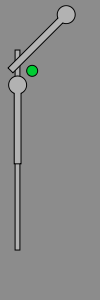
|
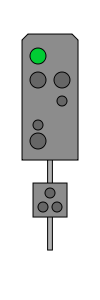
|
|
|

|

|

|
Hp 2 / Vr 2 |
|||
| Signal aspect | Shape signal | Light signal | |
| Day sign | Night sign | ||
|
|

|
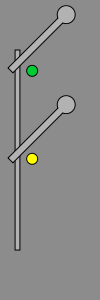
|

|
|
|
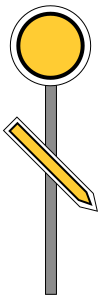
|

|
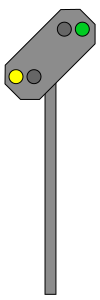
|
Main signal
Not every main signal is set up for all three signal aspects. The combinations are possible:
- only Hp 0 ,
- Hp 0 or Hp 1 ,
- Hp 0 or Hp 2 ,
- Hp 0 or Hp 1 or Hp 2 .
In the case of mechanically set three-aspect form signals, the signal aspect is selected by the direction of rotation of the adjusting disk of the signal drive. In this case, electrical signal drives contain two separate transmission systems.
Distant signal
Fixed pre-signals are usually adjustable, they are (nowadays) moved by a mechanical or electrical signal drive attached to the mast. Mechanical entry pre-signals are usually set together with the associated entry signal with a common cable. In snowy areas, for example in mountainous Saxony, it was and is common to set up your own distant signal lines with a special lever. In this case, the main and distant signal levers are given a sequence dependency with a back lock. The distant signal lever is released when the main signal lever is latched in the driving position. Conversely, the main signal lever can only be reset when the distant signal lever is back in its basic position. Another possibility is to equip such distant signals with electrical drives in mechanical interlockings. Drive lock drives were often used for this . From the 1960s onwards, the Deutsche Reichsbahn increasingly replaced formal pre-signals that were difficult to control mechanically with light pre-signals. With mechanically set extension pre-signals, continuous lines with the associated main signal are hardly possible. They are provided by the nearest signal box and are integrated in such a way that they can only be brought into the driving position when the associated entry and exit signals are on.
The form advance signal has a circular yellow disc with a black frame and white border and a diameter of 100 cm, with guard signals 55 cm. An additional wing can be located under this disc. The wing is yellow with a black frame and a white border, in the area of the former Deutsche Reichsbahn the wing can also be white with a red border (older variant).
Depending on the operational situation, the form pre-signal can be technically set to certain signal patterns, usually Vr 0 / Vr 1 or Vr 0 / Vr 2 or only Vr 0. The end of the protection signal Sh 2; The journey always ends there at the latest. Each shape pre-signal can indicate at least Vr 0.
If the pre-signal is attached to a signal bridge or a signal boom above the track used, the wing is above the disc. In practice, there are no more pre-signals attached to signal bridges or brackets in Germany.
Night signs of the pre-signal are two lights rising to the right in the colors yellow and / or green. For individual pre-signals in the area of the former Reichsbahn, only one light in yellow or green can be shown until further notice.
To avoid signal mix-ups, the night signal of the Vr 2 signal in the area of the former Deutsche Reichsbahn has been made up of a lower green and an upper yellow light since 1959. In order to distinguish it from the Hl light signals introduced in the same year and because similar-looking signal terms could have different meanings, the Deutsche Reichsbahn changed the abbreviations in this context. Main form signal terms were then called Hf, form pre-signal terms Vf, light signal terms of the H / V system Hl 100 to 102 and the associated distant signal terms Vl 100 to 102.
There are no special distant signal terms in the Hl and Ks signal system. Hl pre-signals show the signal terms Hl 1, 4, 7 or 10, Ks pre-signals show the terms Ks 1 or Ks 2, possibly in conjunction with a speed indicator Zs 3v.
Light signals of the H / V system no longer exist in the area of the former Deutsche Reichsbahn, any signal screens that may still be present show signal aspects of the Hl signal system.
Shape signals
When it was first created, the H / V system consisted exclusively of form signals . Form signals were basically available in two variants, which differed in whether it could indicate slow travel (Hp 2) or slow travel (Vr 2). Where possible, a main signal had two wings and the distant signal one additional wing.
In the past century, the reversed color variant of the main signal ("negative wing") with a red core and white border was often used because of the visibility against a dark background. In the meantime, the affected signals have either been replaced by light signals or the wings have been replaced by the normal variant. Only one location of a negative wing is known to exist in Germany: for a number of years there has been such a signal at the eastern entrance to Heiligendamm train station ( MBB ).
Light signals
From 1927 light signals were tested by the Reichsbahn , the signal images of which corresponded to the night signals of the H / V shape signals during day and night. In doing so, they only used the lamps of the form signal night signs combined on one screen and thus managed without mechanically moving signal components. On the one hand, this reduced the maintenance effort, but above all it made it possible to dispense with the long wire pull cables, which were required for the remote setting of form signals, since they could now be set electrically.
In 1935 these light signals were introduced into the signal book , but their use remained limited until the end of the Second World War . In the course of time, various designs were developed for main light signals, which mainly differed in the arrangement of the lamps and the display options for additional signals.
Designs
General
A single-leaf main signal can only use the two terms drive (Hp 1) and stop! Show (Hp 0). It is mostly used as a block signal or an exit and intermediate signal if there is no branching point. In addition, two-aspect signals with Hp1 and Hp0 are sufficient if the line speed does not exceed 40 km / h.
Further combinations are created by additional signals attached to the mast or, if there is insufficient space, set up in front of it .
Since the signal aspects of a main signal were only valid for train journeys , but not for shunting journeys , an additional blocking signal can be set up in front of exit and intermediate signals , the stopping signal of which also prohibits driving past for shunting journeys. In order to avoid this duplication, the Deutsche Bundesbahn supplemented light signal screens with light points for terms of a protective signal: Main signals were now able to prohibit train and shunting movements with the signal term Hp 00 combined from Hp 0 and Sh 0 (two red lights next to each other) to display. This absolute driving ban could be lifted for shunting trips by displaying the signal aspects Hp 0 (a red light) and Sh 1 ( driving ban lifted ).
A similar development was started at the Deutsche Reichsbahn, but with the signal book from 1959, with which the stopping term of all main signals also applied to shunting runs, it could be stopped again. Main shape signals, which should not be valid for shunting trips, received a diamond sign signal Zs 3 (from 1992 Zs 103). Those that were supposed to remain valid for shunting trips and still had to be passed by them were equipped with an additional signal screen that could show the shunting signal Ra 12 with two lanterns. The main light signals of the old light signal system were no longer set up again after 1960 and the existing ones were gradually converted to Hl terms.
Another variant arose at the Deutsche Bundesbahn through the so-called compact signals, which standardized and rearranged the optics of the main signals, which have now become more and more extensive. With these screens, the positions of the lamps were always the same, regardless of which signal aspects the signal could display and whether the lamps were therefore all present or not. If the signal is equipped with a replacement signal or a caution signal , this is integrated in the signal screen and no longer attached separately as with older signals. The signal screen is closed at the back with a cover. H / V compact shields correspond to those of the Ks signals in terms of structure and design. The screen is a sealed box that is accessible through a door on the back, so the housing of the signal lanterns is no longer required. The signal optics are built directly into the housing without a housing and are adjusted by the manufacturer. The compact screen is only set up as a whole during installation.
There are no major differences in light pre-signals, apart from the compact form, which, in contrast to the original form with sloping corners to the right, consists of a simple rectangular signal screen.
Special forms
In the area of the ESO there are various special forms, which, however, show the same signal patterns as the normal light signals and are therefore not considered as independent signals. This includes, for example, special structures in compact form where space is limited, such as in tunnels. Such signals are used in large numbers in the tunnel of the connecting railway (Stuttgart) and were installed in the city tunnel (Frankfurt) until the switch to ESTW in 2018 .
After the railway accident in Dahlerau at the end of the 1970s, line blocks and exit signals were retrofitted on many branch lines in West Germany . If these were mechanical interlockings, light signals and a control panel from Scheidt & Bachmann were retrofitted. The monitoring signals from level crossings were used , the upper lantern of which was given a green colored disk with the distinctive long shielding panel and which were supplemented by a red and, for signals that can show Hp 2, a yellow lantern. In the meantime, many of these lines have been closed and the signals have been taken out of service or removed. Most of the remaining signals were replaced as part of modernizations. Electronic interlockings of the type ZSB 2000 from Scheidt & Bachmann, which among other things replaced the interlockings with branch line light signals on several routes in the area of the Kurhessenbahn , use a design similar to those signals, but which shows Ks signal aspects .
With the SICAS S5, Siemens offered an interlocking system developed in-house, the technology of which was not based, as usual, on special components adapted for the high safety requirements of the railways ( AK 6 according to DIN V 19250 ), but on a programmable logic controller ( SIMATIC S5). The signals used come from the area of the ordinance on the construction and operation of trams and have been used since the 1960s / 1970s, among other things, on subways in western Germany, each with their own signal terms, some of which are based on the H / V terms . In 1995 a SICAS S5 went into operation for the Strohgäubahn for the first time . The exit signals in the intermediate stations showed the normal signal images Hp 0, 1 and 2 until the drive terms with the changeover to the technically supported Zugleitbetrieb through characteristic light have been replaced. Until 2015, the Ammertalbahn had a SICAS S5 with corresponding main and even pre-signals. The Tegernsee and Gmund stations on the Tegernseebahn have also had SICAS signals since 1998. The successor system SICAS S7 uses Ks signal aspects.
Another special design was installed by ADtranz on the Kahl – Schöllkrippen (Kahlgrundbahn) line . Signal lanterns with short diaphragms of Hl signals from WSSB were used here. The signal aspects Hp 0, 1 and 2 are shown.
Branch Line Light ( Castle Forest Railway ), signal image Hp 0
ADtranz signal on the Kahl – Schöllkrippen railway line , signal image Hp 0
See also
Web links
Individual evidence
- ↑ Driving dynamics of rail traffic - winter semester 2004/2005 (PDF; 1.56 MB), Peter Spiess, DB Systemtechnik
- ^ A b c Ralf Roman Rossberg: History of the Railway . Sigloch Service Edition, Künzelsau 1977. or ISBN, pp. 494–495.
- ^ Ludwig Neumann, Paul Ehrhardt: Memories of the construction and the first years of operation of the Leipzig-Dresden railway . Zentralantiquariat der DDR (Reprint), Leipzig 1988, ISBN 3-7463-0141-6 , pp. 34–35.
- ↑ Simon Bradley: The Railways - Nation, Network and People Profile Books, London 2016, ISBN 978-1-84668-213-1 , p. 295.
- ↑ Uwe Miethe (Ed.): Picture Atlas of the German Railway Signals GeraMond, Munich 2011, ISBN 978-3-86245-108-1 , p. 8.
- ^ Wilhelm Cauer: Operation and traffic of the Prussian State Railways. A manual for authorities and officials. First part. Julius Springer, Berlin 1897. p. 69.
- ↑ Erich Preuss: Signals of German Railways - German Federal Railroad / German State Railroad / Deutsche Bahn AG . transpress, Stuttgart 1998, ISBN 3-613-71072-2 , p. 9.
- ↑ Erich Preuss: Signals of German Railways - German Federal Railroad / German State Railroad / Deutsche Bahn AG . transpress, Stuttgart 1998, ISBN 3-613-71072-2 , p. 7.
- ↑ Bernd Kuhlmann: Signal connections. The signal system of the light rail from 1928 . In: Verkehrsgeschichtliche Blätter e. V. (Ed.): Electricity instead of steam! 75 years of the Berlin S-Bahn. The great time of electrification . Verlag GVE, 1999, ISBN 3-89218-275-2 , p. 52-61 .
- ↑ The Hp system on Wolfgang Meyenberg's homepage











